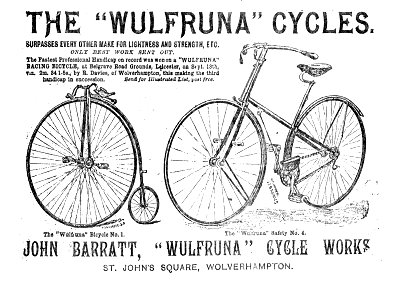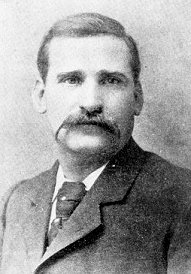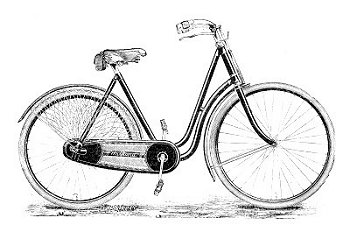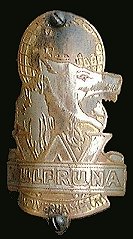 |
Wulfruna Cycles was started by John Barratt in St
John's Square. This advert dates from 1886. An 'Onward' advert
of the same date carries an identical drawing of the safety
machine. So that John Barratt may have made machines for other
manufacturers. |
| John Barratt in 1897. |
 |
| The following is from an 1897 Wolverhampton trade directory: John Barratt, Manufacturer of the "Wulfruna" Cycles, Wulfruna Cycle
Works, Melbourne Street.
Among the names most prominently identified with the growth of the
cycle trade in Wolverhampton there is none better known than that of Mr.
John Barratt, manufacturer of the celebrated "Wulfruna" Cycles, which
justly hold a pre-eminent position both at home and abroad.
For the last
twenty years Mr. Barratt has been engaged in this branch of industry,
and no manufacturer has done more to uphold the reputation of the town
for high-class productions. His business has grown at a steady and
substantial pace, and is now accounted among the largest and most
influential of its character in the district.. In this instance success
has been thoroughly well deserved, for exceptional skill has been allied
to the most enterprising and honourable methods of trading.
The great
demand for "Wulfruna" machines during the season of 1896 sorely taxed
Mr. Barratt's productive facilities, but with characteristic foresight
he has taken steps during the quiet winter period to obviate this
difficulty with regard to the approaching season, by the addition of two
large building shops, a magnificent machine shop, and new finishing,
plating and enamelling shops; the premises now covering a large area of
ground between Melbourne Street and Lever Street, and being equipped
throughout with the most improved English and American automatic
machinery and labour-saving appliances.
The various manufacturing
departments are conveniently arranged to ensure economy of time and
production, and each is under the constant supervision of skilful and
trustworthy foremen. Upwards of three hundred hands are employed, and a
pleasing feature is the good feeling that always exists between
proprietor and workmen. The productions include ladies' and gentlemen's,
girls' and youths' safeties, tricycles, and tandems, fitted with the
best rims, tyres, and gear cases to order; saddles by the celebrated
firm of Messrs. Lamplugh and Co. For beauty of design, light running and
finish, speed and durability, the "Wulfruna" machines stand in the very
front rank, as hundreds of unsolicited testimonials from capable riders
and many flattering press notices - British and foreign - will testify.
The 1897 " Wulfrunas " will be thoroughly up-to-date, and show
improvement upon those of preceding years, and we strongly advise
intending purchasers to send to Mr. Barratt for one of his illustrated
price lists before buying elsewhere. It contains all particulars and
specifications, prices, etc. We cannot better conclude this review of
one of Wolverhampton's chief cycle factories than by wishing the
respected proprietor a continuance of the success he has thus far
enjoyed, and so thoroughly deserved. - Telegraphic Address: " Wulfruna,
Wolverhampton." Telephone No. 7137.
|
|
| The following is a short description of the
Wulfruna No. 7 from "Bicycles & Tricycles of the Year 1889" by Harry
Hewitt Griffin: "The Wulfruna. No.7 Dwarf Safety Light Roadster (J. D. Barratt,
Wulfruna Works, St. John's Square, Wolverhampton). A very good braced
diamond frame is formed by, at the back, three sets of double tubes -
i.e., the upper and lower rear forks, together with double stays from
crank bearing bracket to the boss which forms the union joint connecting
the five tubes, the odd one being the single tube to the centres; the
corresponding lower tube is also single, and the centres pin, which both
join, is extra long, and, the lugs holding it being very firm, the whole
machine, though very light, is exceedingly rigid.
A neat but very slight
curve is given to the front forks, and there is an extra long spoon to
the direct link plunger brake. Tangent spokes are put to the 30in.
wheels, which have ⅝in. rubbers.
Adjustment is made by slots in the rear fork ends, regulated by a set
screw. The machine makes a capital mount for light road-work. With balls
all parts, nicely
enamelled and electro-plated, the list price is £14. The weight is only
about 30lb."
The book also contains the following
description of a Wulfruna tricycle:
"The Wulfruna Direct Steering Roadster (John Barratt, St. John's
Square, Wolverhampton). This machine has a strong, well-stayed frame,
the lower part of the 'V' pattern, but with a connecting stay between
the seat-pillar top and the steering centres. Four sets of Aeolus ball
bearings connect the straight tubular bridge and the axle; the front
forks are weldless steel tube, and the brake is a direct plunger, of
great strength.
Chain adjustment is effected by sliding down the
bracket. Detachable cranks and Bown's square, rubber, Victor ball pedals
are used. It is a good machine, at a very low price; indeed, it is worth
quite as much as some for which £5 or £6 more are asked. Standard size,
36in. drivers, 28in. pilot wheels, geared to 58in. Choice is given of
either ¾in. or
⅞in. tyres. When a lady uses the
machine, the upper stay is easily removable. Net price, enamelled, part
plated, balls all over, £18."
|
|
 |
A 'Wulfruna' bicycle from 1897 |
| The Wulfruna badge on Peter Hällström's bicycle. |
 |
|



